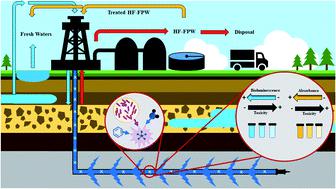当前位置:
X-MOL 学术
›
Environ. Sci.: Processes Impacts
›
论文详情
Our official English website, www.x-mol.net, welcomes your feedback! (Note: you will need to create a separate account there.)
Toxicity of hydraulic fracturing wastewater from black shale natural-gas wells influenced by well maturity and chemical additives
Environmental Science: Processes & Impacts ( IF 5.5 ) Pub Date : 2021-4-8 , DOI: 10.1039/d1em00023c Mina Aghababaei 1 , Jenna L Luek 1 , Paul F Ziemkiewicz 2 , Paula J Mouser 1
Environmental Science: Processes & Impacts ( IF 5.5 ) Pub Date : 2021-4-8 , DOI: 10.1039/d1em00023c Mina Aghababaei 1 , Jenna L Luek 1 , Paul F Ziemkiewicz 2 , Paula J Mouser 1
Affiliation

|
Hydraulic fracturing of deep shale formations generates large volumes of wastewater that must be managed through treatment, reuse, or disposal. Produced wastewater liberates formation-derived radionuclides and contains previously uncharacterized organohalides thought to be generated within the shale well, both posing unknown toxicity to human and ecological health. Here, we assess the toxicity of 42 input media and produced fluid samples collected from four wells in the Utica formation and Marcellus Shale using two distinct endpoint screening assays. Broad spectrum acute toxicity was assessed using a bioluminescence inhibition assay employing the halotolerant bacterium Aliivibrio fischeri, while predictive mammalian cytotoxicity was evaluated using a N-acetylcysteine (NAC) thiol reactivity assay. The acute toxicity and thiol reactivity of early-stage flowback was higher than later produced fluids, with levels diminishing through time as the natural gas wells matured. Acute toxicity of early stage flowback and drilling muds were on par with the positive control, 3,5-dichlorophenol (6.8 mg L−1). Differences in both acute toxicity and thiol reactivity between paired natural gas well samples were associated with specific chemical additives. Samples from wells containing a larger diversity and concentration of organic additives resulted in higher acute toxicity, while samples from a well applying a higher composition of ammonium persulfate, a strong oxidizer, showed greater thiol reactivity, predictive of higher mammalian toxicity. Both acute toxicity and thiol reactivity are consistently detected in produced waters, in some cases present up to nine months after hydraulic fracturing. These results support that specific chemical additives, the reactions generated by the additives, or the constituents liberated from the formation by the additives contribute to the toxicity of hydraulic fracturing produced waters and reinforces the need for careful consideration of early produced fluid management.
中文翻译:

黑色页岩天然气井水力压裂废水毒性受井成熟度和化学添加剂影响
深层页岩地层的水力压裂会产生大量废水,必须通过处理、再利用或处置来管理这些废水。产生的废水释放出地层衍生的放射性核素,并含有以前被认为是在页岩井内产生的未表征的有机卤化物,这两种物质都对人类和生态健康构成未知的毒性。在这里,我们评估了 42 种输入介质的毒性,并使用两种不同的终点筛选测定法从 Utica 地层和 Marcellus 页岩的四口井中采集了流体样本。使用耐盐细菌Aliivibrio fischeri的生物发光抑制试验评估了广谱急性毒性,而预测性哺乳动物细胞毒性使用N-乙酰半胱氨酸 (NAC) 硫醇反应性测定。早期回流的急性毒性和硫醇反应性高于后期生产的流体,随着天然气井的成熟,水平随着时间的推移而降低。早期返排和钻井泥浆的急性毒性与阳性对照 3,5-二氯苯酚 (6.8 mg L -1)。成对的天然气井样品之间的急性毒性和硫醇反应性的差异与特定的化学添加剂有关。来自含有更大多样性和浓度的有机添加剂的井的样品导致更高的急性毒性,而来自应用更高组成的过硫酸铵(一种强氧化剂)的井的样品显示出更大的硫醇反应性,预示着更高的哺乳动物毒性。在采出水中始终检测到急性毒性和硫醇反应性,在某些情况下,在水力压裂后长达 9 个月内仍然存在。这些结果支持特定的化学添加剂,添加剂产生的反应,
更新日期:2021-04-13
中文翻译:

黑色页岩天然气井水力压裂废水毒性受井成熟度和化学添加剂影响
深层页岩地层的水力压裂会产生大量废水,必须通过处理、再利用或处置来管理这些废水。产生的废水释放出地层衍生的放射性核素,并含有以前被认为是在页岩井内产生的未表征的有机卤化物,这两种物质都对人类和生态健康构成未知的毒性。在这里,我们评估了 42 种输入介质的毒性,并使用两种不同的终点筛选测定法从 Utica 地层和 Marcellus 页岩的四口井中采集了流体样本。使用耐盐细菌Aliivibrio fischeri的生物发光抑制试验评估了广谱急性毒性,而预测性哺乳动物细胞毒性使用N-乙酰半胱氨酸 (NAC) 硫醇反应性测定。早期回流的急性毒性和硫醇反应性高于后期生产的流体,随着天然气井的成熟,水平随着时间的推移而降低。早期返排和钻井泥浆的急性毒性与阳性对照 3,5-二氯苯酚 (6.8 mg L -1)。成对的天然气井样品之间的急性毒性和硫醇反应性的差异与特定的化学添加剂有关。来自含有更大多样性和浓度的有机添加剂的井的样品导致更高的急性毒性,而来自应用更高组成的过硫酸铵(一种强氧化剂)的井的样品显示出更大的硫醇反应性,预示着更高的哺乳动物毒性。在采出水中始终检测到急性毒性和硫醇反应性,在某些情况下,在水力压裂后长达 9 个月内仍然存在。这些结果支持特定的化学添加剂,添加剂产生的反应,



























 京公网安备 11010802027423号
京公网安备 11010802027423号